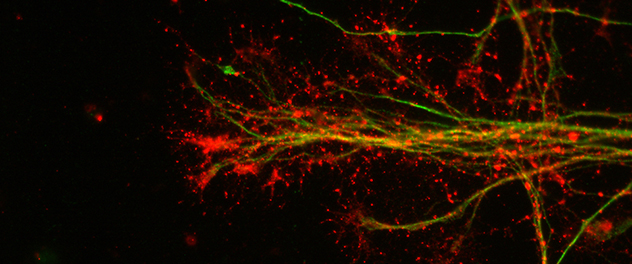Neural Stem Cells for CNS Regeneration

Human induced pluripotent stem cell-derived neural stem cells showing growth cone associated with protein-43 (red) and neurofilament H (green).
Neural stem cells hold a transformative potential for repairing the central nervous system, offering new prospects for treating a myriad of injuries and diseases. These injuries and diseases range from spinal cord injuries and stroke to neurodegenerative conditions such as Alzheimer's disease, Parkinson's disease and multiple sclerosis.
Research in this area has accelerated, exploring both the therapeutic transplantation of neural stem cells and the activation of endogenous neural stem cells to promote repair and regeneration within the central nervous system. Research continues to unravel the complexities of neural stem cell biology and the interactions of neural stem cells within the central nervous system environment. Understanding these dynamics is crucial for advancing stem cell therapies from experimental models to clinical applications for central nervous system repair, offering hope for recovery from central nervous system injuries and diseases previously considered irreversible.
Recent studies from Dr. Scarisbrick's Neuroregeneration and Neurorehabilitation Laboratory demonstrate that blocking the thrombin receptor protease-activated receptor 1 (PAR1) promotes the expansion of neural stem cells and their differentiation along the myelin lineage. Efforts are underway to determine the significance of targeting PAR1 to improve the innate capacity for stem cell-mediated regeneration. This includes evaluating the success of engrafting neural stem cells to restore function in cases of neurological injury and disease.
Related publications
- Triplet EM, Kim HN, Yoon H, Radulovic M, Kleppe L, Simon WL, Choi CI, Walsh PJ, Dutton JR, Scarisbrick IA. The thrombin receptor links brain derived neurotrophic factor to neuron cholesterol production, resiliency and repair after spinal cord injury. Neurobiology of Disease. 2021; doi10.1016/j.nbd.2021.105294.
- Yoon H, Choi CI, Triplet EM, Langley MR, Kleppe LS, Kim HN, Simon WL, Scarisbrick IA. Blocking the thrombin receptor promotes repair of demyelinated lesions in the adult brain. Journal of Neuroscience. 2020; doi:10.1523/JNEUROSCI.2029-19.2019.
- Choi C-I, Yoon H, Drucker KL, Langley MR, Kleppe L, Scarisbrick IA. The thrombin receptor restricts subventricular zone neural stem cell expansion and differentiation. Scientific Reports. 2018; doi:10.1038/s41598-018-27613-9.